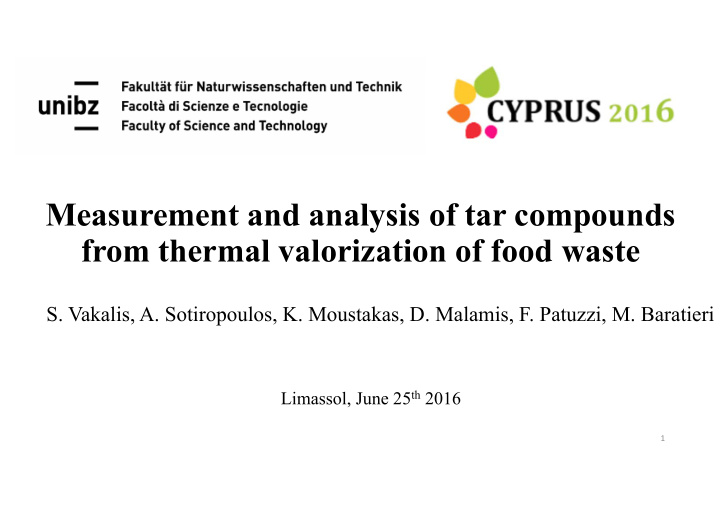



Measurement and analysis of tar compounds from thermal valorization of food waste S. Vakalis, A. Sotiropoulos, K. Moustakas, D. Malamis, F. Patuzzi, M. Baratieri Limassol, June 25 th 2016 1
Background • Household waste were sampled, dried and thermally treated for the production of carbonaceous fuels. • Gaseous products from thermal treatment of biomass contain amounts of tar compounds. Tar - heavy organic compounds Tar consists from condensable organic hydrocarbons with a molecular weight bigger than benzene [Neeft et al, 1999] 2
Background (2) • Pyrolysis gases are utilized for energy recovery • Tar compounds cause clogging of the filters, the pipelines and the cylinders of internal combustion engines. • Until now, there is a lack of technical standards for onsite sampling and for analyzing tar compounds. • In particular, tar sampling from raw gas encounters several difficulties. • In addition, there is not a standarized approach for quantification of tar compounds • "In most forms of mass spectrometry, the intensity of ion current measured by the spectrometer does not accurately represent relative abundance, but correlates loosely with it. Therefore it is common to label the y -axis with arbitrary units". 3
Scope • PAHs are a big fraction of the total tars and the paramount reason of pipes/ engines clogging and corrosion. • Naphthalene tends to be the dominant tar compound in higher temperatures (Mitchel et al., 2011 and Prando et al., 2016) • The scope is to accurately sample and quantify naphthalene from raw gas of thermal treatment of food waste. 4
Sampling of food waste and drying • Household biowaste were sampled and dried in a commercial dryer. • The structure and the inherent characteristics of organic municipal waste makes the implementation of thermal processes a difficult task. • Common problems: high moisture & ash, particle size, inhomogenious • Through efficient dehydration and milling, thermal processes become possible 5
Benefits of drying household waste Also glucose level stays (relatively) stable ! Avg. moisture of HW 75% ‐ 95% 70% reduction Avg. moisture of dried HW 7% Source: Sotiropoulos A., Malamis D., Loizidou M., (2015). Dehydration of Domestic Food Waste at Source as an Alternative Approach for Food Waste Management. Waste and Biomass Valorization, ISSN 1877-2641, pp6:167-176 6
Utilization of Thermal Conversion Processes Source: S. Vakalis, A. Sotiropoulos, K. Moustakas, D. Malamis, K. Vekkos, M. Baratieri. (2016). Thermochemical valorization and characterization of household bio ‐ waste. Journal of Environmental Management. 7
Scheme of process and products 8
Elemental Analysis of Solid Fractions Dried Torrefaction Carb. High T Pyrolysis HW 265 °C 550 °C 850 °C % wb C 42.56 54.96 42.07 53.54 H 6.10 5.01 1.05 1.10 N 1.76 2.43 1.84 1.88 Ash 14 27.85 36.23 37.14 H 2 O 7 - - - Source: S. Vakalis, A. Sotiropoulos, K. Moustakas, D. Malamis, K. Vekkos, M. Baratieri. (2016). Thermochemical valorization and characterization of household bio ‐ waste. Journal of Environmental Management. 9
Tar sampling The application of the tar protocol is becoming a standardized approach for gasification systems. But several issues have to be taken into consideration for raw gas sampling and the protocol should be expanded to include other thermal treatment methods. Source: J.P.A. Neeft, H.A.M. Knoef, P. Onaji , (1999). Behavior of tars in biomass gasification systems. Maarn , The Netherlands 10
Analysis of tar compounds • GC- MS unit (Agilent 5977A). • Addition of a specialized column for tar analysis. • Identification of retention times for selected tar compounds • Calibration of the instrument by means of solutions with different naphthalene concentrations. • Calibration for tar cracking 11
Developement of calibration curves 12
Identification of retention times (GC column) Species with RT less than 20s Species with RT more than 20s Benzene 3.179 Naphthalene 20.509 Toluene 5.544 Benzo[c]thiopene 20.683 Pyridine, 3-methyl- 7.575 Quinoline 22.044 Pyridine, 2-methyl- 9.214 Isoquinoline 22.729 Styrene 10.253 Indole & Naphthalene, 2-methyl 23.737 Benzonitrile 13.768 Naphthalene, 1-methyl 24.164 Benzofuran 14.137 Biphenyl 26.052 Indene 15.837 Naphthalene, 2-ethenyl- 27.423 Benzonitrile, 2-methyl- 16.624 Acenaphthylene 27.94 Benzonitrile, 4-methyl- 17.404 2-Naphthalenecarbonitrile 29.058 13
Results: GC-MS Torrefaction Naphtalene 14
Results: GC-MS Carbonization Naphtalene 15
Results: GC-MS HT Pyrolysis/ Gasification Naphtalene 16
Results: naphthalene quantification Torrefaction Carbonization High T Pyrolysis ‐ Naphthalene concentrations (mg/ Nm 3 ) ‐ Curve A 6.32 12.04 7.49 Curve B 8.92 15.95 10.58 17
Discussion and Conclusions • A tar sampling standard for all the onsite thermal treatment facilities should be developed. • Improvements in the existing methods should accomodate the sampling of tar from raw gas. • In our case, lab scale operation prevented common problems • Char enhances the cracking of naphtalene.Thus, napthalene in high T Pyrolysis gases has smaller concentrations than Carbonization. • Other species were identified like Indene, Pyridine and Biphenyl but their quantification will be presented in future publications. 18
THANK YOU FOR YOUR ATTENTION! For further info: stergios.vakalis@outlook.com 19
Recommend
More recommend